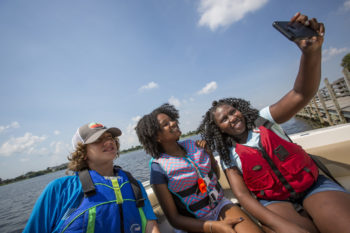5 Ways Parents and Caretakers Can Keep Children and Teens Safe in the Water
7.19.2022 | Ashley Speller
 As warmer temperatures continue to increasingly draw crowds to the water, it’s important to keep safety in mind, especially when children and teens are involved.
As warmer temperatures continue to increasingly draw crowds to the water, it’s important to keep safety in mind, especially when children and teens are involved.
Dr. Linda Quan, a pediatric emergency medicine physician at Seattle Children’s spoke with KUOW where she shared her five most valuable pieces of water safety advice for parents and caretakers.
Wear a Lifejacket
Life-threatening accidents can happen in the water in a matter of seconds. In fact, drowning can occur in as little as thirty seconds. Wearing a life jacket that is Coast Guard-approved and fits properly can help prevent avoidable tragedies.
When boating, it’s also important to remember that Washington state law requires all vessels, including canoes, kayaks and stand-up paddleboards to have at least one life jacket per person onboard, with children under 13 required to always wear them.
There are also life jacket loaner programs available where families can borrow lifejackets for free at over 200 locations across the state.
“I want everybody to be prepared about knowing what kind of water they’re going to and protecting their very own family members and friends by putting them in a lifejacket,” she told KUOW listeners.
Swim Where There’s a Lifeguard
Several beaches are expected to be without lifeguards in some areas of Seattle and King County this summer, and drownings that could have been prevented with the use of a lifejacket have risen over the past five years, as reported by KING5.
“I want parents also to look, watch and recognize who’s in trouble in the water.
“We all have been misled by the film industry in the belief that drowning involves making noise. It does not,” Quan added. “It actually keeps one from making noise. When you’re drowning, you are just trying to breathe, and you cannot breathe, talk, scream and yell for help at the same time.”
Quan urges parents and caretakers to always stay vigilant. Whether or not a lifeguard is present, you need to be the first line of defense.
Provide Good Supervision
With drowning identified as a leading cause of unintentional injury death among children and youth in Washington state, a key step in keeping kids safe around water is ensuring they are appropriately supervised. That means watching constantly, providing touch supervision for young children and avoiding distractions such as the cell phone, a book or chatting. Supervising the kids around the water is a JOB.
Knowing who is at greater risk can help focus your supervision. “Males are at much greater risk,” Quan said. Teens who seek unsupervised time in the water and young children who wander in during non-swim times are also at high risk for drowning.
Learn How to Swim
Swim lessons teach lifesaving skills that are essential for children to learn early on as it’s often less likely they will start taking formal lessons in adulthood. The American Academy of Pediatrics suggests that swim classes can typically begin around 4 years old in most cases.
Quan said while it would be ideal for everyone to learn how to swim she acknowledges that there are disparities that have prevented many families from learning the swimming skills they need growing up.
“Drowning is not a fair injury. It is definitely an injury, like many others, that disproportionately affects certain groups,” Quan explained. “We know that there is a huge component of the social determinants of health among certain racial groups; that African Americans in our country have been denied historically access to not only swimming pools, but also swimming lessons, and therefore have actually decreased their familiarity, comfort, and swim skills because of that historical component.” However, what everyone in the family can learn are the other water competencies such as good supervision, wearing a life jacket and first aid and CPR to help keep their family safe.
Learn First Aid and CPR
CPR skills are also important for the entire family to learn. In fact, according to the American Heart Association, children as young as nine can learn and retain CPR skills.
“What you need to do is to take a first-aid course that teaches how to respond safely, because we also see family members responding to a drowning, and very often it’s a tragedy because the responding person, the would-be saver, actually drowns,” Quan said.
Keeping these helpful tips in mind will ensure everyone can enjoy the water safely and work together to prevent unnecessary tragedies from happening in their communities.
Resources
- Water Safety Tips for Families
- Life Jackets for Children and Teens
- Life Jacket Coupon for Big 5 Sporting Goods
- Water Safety for Children Birth to 5 Years
- Water Safety for Teens 12 to 18 Years Old
- Resources for Drowning Prevention Professionals
- Drowning prevention en español: prevención de ahogamiento